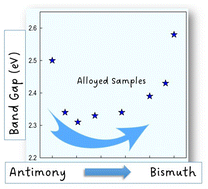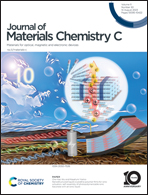Band gap tuning through cation and halide alloying in mechanochemically synthesized Cs3(Sb1−xBix)2Br9 and Cs3Sb2(I1−xBrx)9 solid solutions†
Abstract
Modulation of the optical properties of lead-free defective perovskites can contribute to the design of optimized materials for several applications ranging from photodetection to photocatalysis. Here, we explored two novel alloying strategies in Cs3Sb2Br9 by preparing, through mechanochemical synthesis, Sb/Bi and Br/I mixed systems. An unexpected band gap bowing has been observed in alloyed Sb/Bi compositions, showing lower absorption edges with respect to pure compounds. Such behavior has been computationally modelled suggesting the presence of local aggregates as the source of such a reduction of the band gap. Further modulation of the optical properties has been achieved by halide alloying showing a progressive red-shift by increasing the iodide content. In both cases, full solubility at the solid state has been determined by means of diffraction and Raman spectroscopy. Overall, this study proposes and rationalizes doping strategies in the Cs3Sb2Br9 defective perovskite, achieved through the use of a sustainable synthetic procedure such as mechanochemistry.

- This article is part of the themed collection: 2023 Journal of Materials Chemistry C Most Popular Articles


 Please wait while we load your content...
Please wait while we load your content...